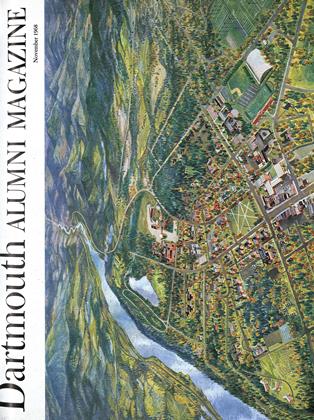By Richard L. Hayes '20.Beverly Hills (Calif.): Trail-R-Club ofAmerica, 1968. 96 pp. $2.50. Paperback.
This book contains highly charged praise about the joys - and bargains - of togetherness in a mobile home park. No fewer than 80 pictures, some full-page, tell the "Fascinating True Story of 'Country Club' Living for Retired People of Modest Means," as the subtitle informs us. The illustrations show tea parties and dances and masquerades, shuffle board contests, pitch-and-putt golf courses, swimming pools, beach picnics and horseback riding, reading lounges and recreation halls, bridge for foursomes and poker for men only, palm trees and well-cultivated lawns for foregrounds, and ocean and mountains as backdrops.
If something less than romantic, you are hard-headed with a yearning for facts, here they are. In 1967, 220 factories produced 240,980 mobile homes sold through more than 7,000 retail outlets with a total value exceeding $1,375,000,000. The average cost for a unit in the East is $2,300; in the West, $5,700; deluxe models, $12,000. In use today are 1,750,000 mobile homes occupied by 4,500,000 persons. The United States has 22,000 mobile home parks and 1,700 campgrounds for travel trailers. For upkeep, read the title, but actually it need be only $245 a month.
Is this the life for you? Here are the reasons for living in a mobile park as given by persons who have smiled a yes: Less upkeep 44%, lower purchase cost 38%, mobility 33%, compactness 27%, lower cost than renting 26%, no other housing available 3%, other 14%.
The book informs us that residents of mobile homes exhibit a spirit of adventure and that they are "very sociable, but certainly not noisy or irritating to their neighbors." The habit of talking to oneself is broken within the first half-hour after arrival. There is always something going on from early morning until bedtime. It is the sort of togetherness which would scare the daylights out of a hermit.
 View Full Issue
View Full Issue
More From This Issue
-
 Feature
FeatureThe Woes of the Hoit Brothers
November 1968 By John Hurd '21 -
 Feature
FeatureTHE VICE VERSA VIRTUES
November 1968 -
 Feature
Feature1953's Triple Alliance
November 1968 By CLIFF JORDAN '45 -
 Feature
FeatureANOTHER COLLEGE YEAR BEGINS
November 1968 -
 Article
ArticleWith the Big Green Teams
November 1968 -
 Class Notes
Class Notes1935
November 1968 By RICHARD K. MONTGOMERY, C. HALL COLTON, THOMAS E. WILSON
JOHN HURD '21
-
 Article
Article"Suicide" Is Not for Cowards
March 1948 By JOHN HURD '21 -
 Books
BooksALEXANDER POPE. ELOISA TO ABELARD WITH THE LETTERS OF HELOISE TO ABELARD IN THE VERSION
MAY 1966 By JOHN HURD '21 -
 Books
BooksBARBARY GENERAL, THE LIFE OF WILLIAM H. EATON.
APRIL 1968 By JOHN HURD '21 -
 Books
BooksSELECTED WRITINGS OF OSCAR WILDE.
JUNE 1969 By JOHN HURD '21 -
 Books
BooksFurther Mention
JANUARY 1972 By JOHN HURD '21 -
 Article
Article1972 Course Guide
JANUARY 1973 By JOHN HURD '21
Books
-
 Books
BooksWE THE PEOPLE
May 1933 -
 Books
BooksThe Biology of Death
June, 1923 By H. G. Coar -
 Books
BooksIntrepid History
DECEMBER 1982 By J. Craig Kuhn '42 -
 Books
BooksKate Sanborn, July 11, 1839 - July 9, 1917
November 1918 By J.K.L. -
 Books
BooksDARTMOUTH SONG BOOK
April 1950 By JUD LYON '4O -
 Books
BooksPROJECTIVE GEOMETRY
January, 1931 By Robin Robinson


